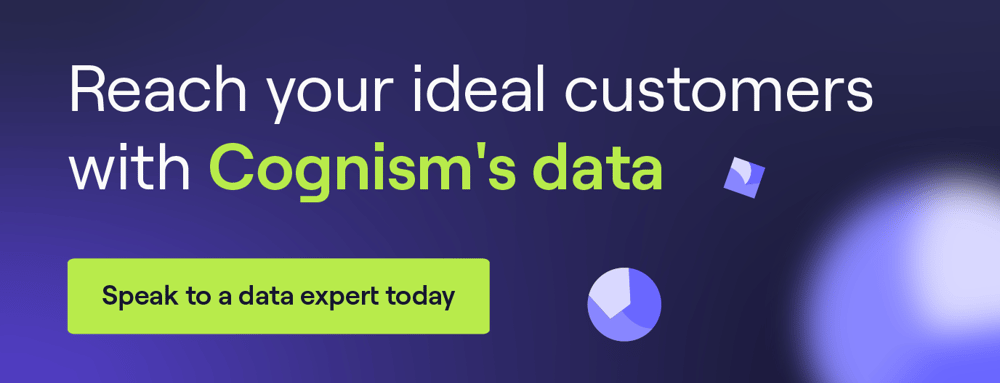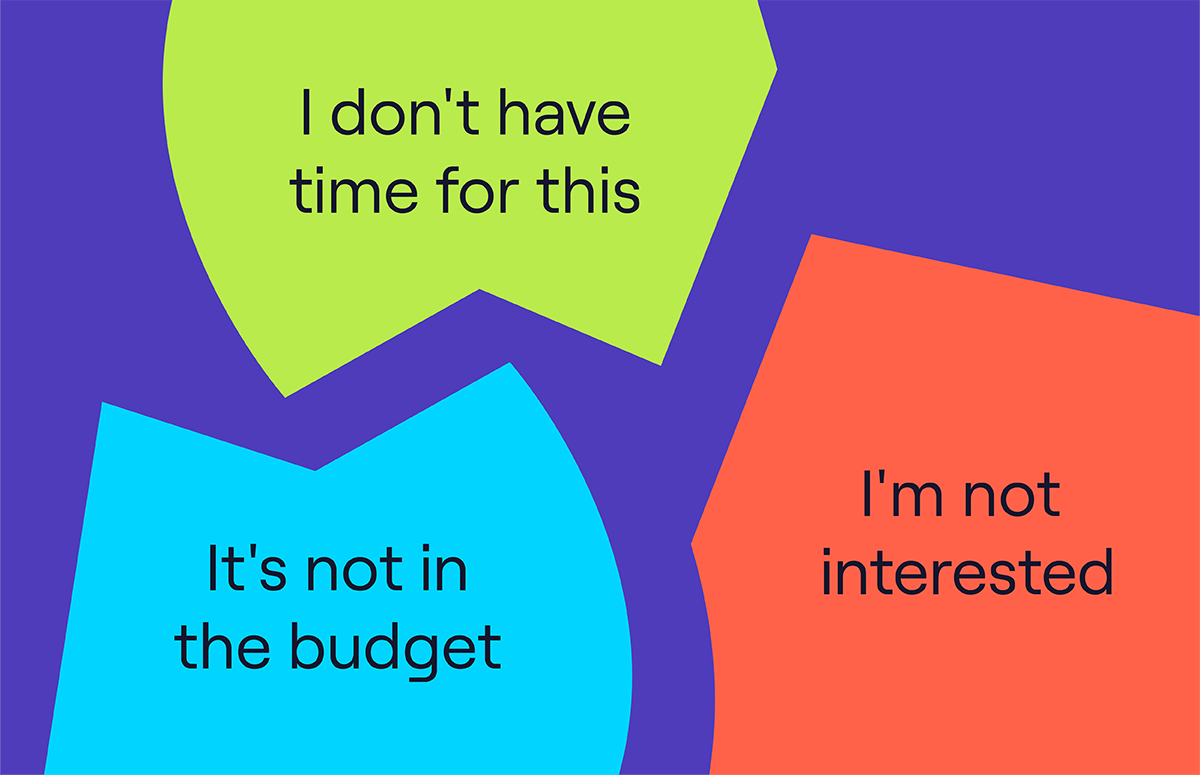What is Cold Calling? Biggest Challenges Solved + Resources
If you think cold calling is a waste of time, think again.
Most buyers (82%) are open to meetings with sales reps who cold call them.
And, yeah, it’s an intimidating lead generation strategy, but it’s a great way to find potential customers and build relationships.
At Cognism, our sales experts excel in the refined art of cold calling. To enhance your strategy, we’ve assembled our best cold calling techniques, complete with live demonstration videos and essential resources for sales representatives.
Let’s begin 👇
What is cold calling?
Cold calling refers to reaching out to potential customers who haven’t interacted with a salesperson before. It’s a type of B2B telemarketing and is one of the oldest and most common marketing methods.
It’s called a cold call because the SDR has no prior interaction or relationship with the prospect (potential customer), which is quite different from warm calling.
It typically involves phone calls but can also include emails or other forms of communication. The goal is to introduce a product or service to a prospect who may not be actively seeking it, with the hope of generating interest, setting up further discussions, or closing a sale.
Traditionally, cold calling involved phoning a broad audience trying to sell something. It was interruptive, pushy, and had low success rates.
Nowadays, B2B cold calling is more targeted and effective. It focuses more on customer needs, delivers a valuable message, and is quantifiable.
The success of cold calling largely depends on how well the salesperson understands the prospect’s needs and pain points and how well they tailor their pitch accordingly.
Although it can be an effective way to reach new clients, it also comes with its own challenges and requires a specific skill set to succeed.
How to cold call: the cold calling process
Most organisations that wonder if cold calling is dead aren’t leveraging the latest tips and techniques correctly. Cold calling succeeds with well-targeted accounts and thorough preparation guided by expert tips.
Here’s a breakdown of a typical cold calling process:
1. Define the call’s objectives
Before you pick up the phone, you need to work out what you want to achieve.
Are you looking to schedule an appointment, close a sale, qualify them, or invite them to an event?
Keep your objective in mind, and don’t stray from it.
Remember, cold calling is just one part of a multi-stage sales process. Focus on what you need to do on your cold call, no more and no less.
For example:
A cold call is typically the first interaction between you and a prospect, so the worst thing you can do is bring up pricing. You first need to gain the right to talk about budget. For most SDRs, pricing is irrelevant. Let your AEs handle that!
Kyle Coleman, CMO at Copy.ai, explains:
“It’s really unnatural for an SDR to ask budget questions, especially if it’s an outbound sourced opportunity. It’s presumptuous for an SDR to start talking about budget - you’ve not yet earned the person’s time for a demo.”
“Instead, it’s about entirely focusing on pain. Does the prospect have a problem that we can solve? And then the seniority aspect, too - can the prospect help move the deal forward?”
He shared this, plus other insights, on our sales leadership podcast, Redefining Outbound. Tune in below 👇
2. Research your prospects before you call
Before making sales cold calls, it’s crucial to gather information about your prospects. Reps can use a B2B contact database, company websites, various social media platforms (LinkedIn is best from a professional point of view) and industry-specific directories to research the company or individual they’re contacting.
Having even a small amount of context can help establish rapport and make your initial conversation more relevant and engaging.
Here’s an example:
You need to cold call a VP of Sales in an enterprise company.
To do this, you’ve got to research and build a strong business case, and you can do that by cold calling individuals below the VP of Sales (who are going to be the ultimate end-user of the product). 👇
VP of Sales
VP of Sales Development
Director of UK Sales
SDR Managers
SDRs
Reaching out to different reps and managers under the VP of Sales can give you insights on issues within the sales team that require attention.
Talking to end-users about issues like missing targets or data quality can help you communicate more effectively with the VP of Sales or the main decision-maker while also emphasising the problem’s urgency.
Frida Ottosson, VP of US Sales at Cognism, loves the bottom-up approach for her team:
“I always advise my team on the bottom-up approach and cover topics like the organisation’s characteristics (size, industry), priorities, and what the team(s) below the executives are saying. This allows you to develop a super relevant message to the C-suite executive.”
Research of over 10,000 phone calls showed that individuals at the C-Suite level were the most likely to answer.
3. Prepare a script
After identifying and researching potential leads, sales representatives should prepare a script or talking points outlining the key benefits of their product or service.
A cold calling script serves as a guide for SDRS to structure their conversations. A good script is flexible but provides a framework that helps a salesperson cover key points, ask relevant questions, and address common objections.
For instance, a script might begin with an introduction or opening line, followed by a value proposition, and then move to qualifying questions designed to assess whether the prospect could benefit from the offered product or service.
This preparation can help build confidence and ensure that the SDR conveys important information effectively during the call.
Here are a few of our best cold calling scripts:
4. Use a cell phone numbers list
The nature of cold calling has changed post-pandemic, with many stakeholders working from home. But this doesn’t mean you can’t achieve great results!
Many companies are opting to work remotely full-time. With fewer people in the office, even direct dials are becoming less valuable. For cold callers, it’s more important than ever to find leads’ cell phone numbers.
At Cognism, we’ve noticed the change and so we’ve developed global mobile phone coverage so that SDRs can connect with prospects even in hybrid work settings.
And we’ve got the biggest and most accurate mobile data database. Why?
Because our data is phone-verified to ensure you’re speaking to the right person. Our data team manually verifies the numbers in our database. So when you need to find CEOs’ phone numbers, Cognism will make it happen.
Here’s what OneUp Sales said about Cognism’s Diamond Data®:

“In Q4, 89% of the numbers called were valid. Cognism eliminates the stress of having the wrong number. The SDRs have pulled data from Cognism for every demo booked. For every deal closed, the AEs have used the database to pull relevant contact details to influence the deal.”
5. Enrich cold call lists with actionable data
Once you have a list of qualified prospects, enrich it using a B2B database provider to ensure accuracy - a vital tip for successful cold calls. It’s crucial that this data is fresh, accurate and compliant. Contact data decays very quickly, and when it does, it becomes useless.
Fortunately, sales intelligence tools update their databases when a prospect leaves a company, gets promoted, etc. Using them significantly increases the likelihood of cold-calling the right person and having a meaningful conversation.
Cognism’s Chrome extension provides an easy and effective way of enriching the following:
- Salesforce and Outreach records without leaving them.
- LinkedIn profiles.
- Sales Navigator lists.
- And viewing key account and prospect information on corporate websites in the browser.
Find out why the Cognism Chrome extension is every rep’s favourite cold calling tool - watch this walkthrough 👇
6. The cold call
Once on the call, a sales rep will introduce themselves and explain why they’re reaching out.
Establishing a friendly and professional tone right from the start is essential, as first impressions matter.
This is often followed by a tailored value proposition or sales pitch highlighting how the product or service can solve a prospect’s problem.
However, B2B sales is open to experimentation. Sales leader Josh Braun likes to do something he calls “poke the bear.”
Instead of being very ‘sales-y’ and going in with a product pitch, you must arouse the prospect’s curiosity.
How do you do this?
You can get your prospects to think about their company and their processes.
Is their current process really delivering results for them?
Or can you show them a better way?
To start poking the bear, be comfortable with mirroring. Repeat what your prospects say back to them - sometimes, things that sound sensible coming out of our mouths sound ludicrous when coming out of someone else’s.
For example - if the prospect says:
“All my sales team manually find their leads.”
You can say:
“Your sales team find ALL their leads MANUALLY?”
You’ve spotted a problem the prospect wasn’t aware of!
Josh expands on his theory:
“You’ve got to get them to think differently, scratch their head and think ‘hmm, maybe I do need this, let me look into this some more’.”
Another effective cold calling technique involves asking open-ended questions, allowing prospective clients to share their challenges and needs.
This tactic, also called sales qualification, helps the rep determine whether the prospect’s needs match the solution they offer.
You don’t need to worry about progressing your cold calling lead down the sales funnel if there’s no fit.
7. Handling objections
Prospects are likely to have concerns about the product or service you’re selling. To move the deal forward, you must try to alleviate them.
The good news is that sales objections aren’t a sign that the prospect isn’t interested. Quite the opposite!
Objections during a cold call indicate that the prospect is interested but doesn’t yet fully understand your product or service. As a salesperson, it’s your job to give them that understanding.
Successful sales teams prepare their reps with objection handling and rebuttals for calls.
For example, an SDR might address a cold calling objection by providing evidence of their product’s effectiveness, sharing case studies of similar customers, or offering a trial period to ease concerns.
At Cognism, we follow a five-point plan when facing objections:

Here’s how this works in practice. A prospect may say:
“I’ve heard your data isn’t that great.”
You can then ask them a question - like this:
“What have you heard about Cognism’s data?”
This is a very searching question, encouraging the prospect to open up and reveal their objections. They might say something like:
“I’ve heard it isn’t GDPR-compliant, which is very important to my business.”
In which case, you’d tailor your response by offering a solution like this one:
“Cognism is GDPR-compliant and registered with the ICO, the UK regulator. Our platform was designed in collaboration with a top-tier legal firm, and our patented AI verifies our data daily and in real-time, maintaining accuracy and compliance.”
You can then confirm by asking:
“Does that make sense?”
If the prospect says “yes, “you can move on to a new question. If they say “no,” you’ll need to explain further.
In our latest cold calling report, we discovered that our SDRs encounter these four objections the most:

We coach our SDRs on one particular framework for handling objections like this:
Feel, Felt, and Found.
- Feel - Open with empathy and make your prospect feel heard.
- Felt - Show the prospect that the problem isn’t unique or exclusive to them.
- Found - Tell the prospect what you’ve typically found to be the problem when speaking with others in the same position.
Here’s how it looks in practice:
“That’s super interesting and definitely a common issue. Typically, when speaking with others [insert persona/title here], I’ve found that they’ve also experienced the same problem…”
8. Close or follow up
If the call goes well, an SDR may close by setting a follow-up meeting, sending over additional information, or even beginning the sales process.
The first step for effective cold calling is to stay calm. Be assertive and clear about what you want.
Beyond that, here are three sure-fire tactics to reel them in:
Tactic one: Seeing the product
Tell the prospect that they’ll find more value from seeing the product in action rather than having you explain it to them over the phone. Ask them if they have time to see it.
Tactic two: Wasting their time
Suggest that your cold call is actually a waste of the prospect’s time. Wouldn’t they rather see a demo?
The dialogue might go something like this:
“Look, (first name), rather than me rambling on at you, would you be against seeing the platform over a 15-minute call? I could run personalised searches for you based on your target market and show you the quality and quantity of data we have.”
Tactic three: Offer a freebie
This tactic is a favourite of Outbound Sales Coach Ryan Reisert. He said:
“Offer the prospect something for free. It can be a workshop or free offer where they can come away at least learning something new or getting something they can immediately put into action.”
Here’s how this might sound at Cognism:
“Do you have any objection to setting up a 10-minute meeting where we can quickly build you an intent-based or trigger-based lead list and give you a free data sample to see how our data compares to what you’re using today?”
If the prospect isn’t ready to decide, you should schedule a follow-up. This is important because many successful sales don’t happen immediately during a cold call but over multiple interactions.
9. Post-call review
After each call, reviewing what went well and what could be improved is beneficial.
Sales reps often track their cold calling metrics, including the number of calls they make, the number of answers, and the outcomes. A CRM system can help keep track of this data, making it easier to manage prospects and follow-ups.
Cognism has its own cold calling process based on years of research and testing by our SDRs.
It begins with steps to take pre-call and ends with post-call activities.
Right-click and save this infographic. You can refer back to it when building out your cold calling process 👇

Cold calling challenges
Cold calling is undeniably one of the most challenging sales techniques. Some of the main hurdles include:
1. High rejection rate
Rejection is a routine part of cold calling.
While cold call rejection can be discouraging for many sales professionals, building resilience and maintaining a positive attitude are essential to overcoming this hurdle.
Understanding that success rates can be low, but the more experience you have, the better you’ll become at refining your approach.
On average, only about 28% of cold calls are answered, with many going to voicemail or ignored entirely.
The average cold call success rate is 2.3%. Which is half of what it was 12 months ago.
Jonty Jewels, Cognism’s Senior Mid-Market Sales Manager for EMEA, says
“This past year has been a tough tech market. Companies are trying to reduce their tech stack and become more efficient. The appetite to buy software is much less. Which means it’s about finding the right people who are still buying at the right time.”
To succeed in cold calling, reps need to be more strategic than ever before.
💡Here’s an article on how to stay motivated while cold calling that might lift your spirits.
2. Unqualified leads
One drawback of sales cold calling is that prospects may not always be a good fit for the product or service offered.
This is where pre-qualifying leads with open-ended questions becomes critical.
Pre-qualifying leads allow you to concentrate on the most interested customers, helping you prioritise your sales efforts.
This process will save your team time and energy in the long run because your cold calling efforts will be more targeted and focused on prospects who will most likely need a solution like yours for a pain point.
3. Time consuming
Cold calling can be a time-intensive process.
It often takes multiple attempts before a salesperson can reach a prospect, and even when they do, they may only sometimes get past the gatekeepers (e.g., receptionists or assistants).
On average, connecting with a lead takes three cold call attempts.
But if you have a prospect’s cell number, you can skip the gatekeeper and connect directly with your target prospect.
David Bentham, VP of GTM at DinMo, is a strong supporter of this:
“With mobile numbers, you will get the highest response rate. In terms of cold calling in the US, calling cell phone numbers is the norm, and while in Europe it’s less common, mobiles still do work.”
“Remember, you don’t have to use a mobile number for cold calling purposes in isolation. My team has seen great value in using this contact information for texting or voicemails.”
“WhatsApp is a fantastic tool to supplement your sales efforts right now, especially as they’re defining themselves more as a business tool.”
Looking for cell numbers? Why not test Cognism’s B2B data for the most successful cold calling 👇

“On average, 70% of monthly meetings are booked over the phone and every mobile number is pulled from Cognism”
4. Negative perception
Cold calling lead generation is often associated with telemarketing, which many people find intrusive.
As a result, SDRs can face resistance even before they can explain why they’re calling.
Overcoming this negative perception requires careful, respectful communication and the ability to convey value quickly.
5. Regulatory and ethical concerns
In many regions, including the UK, strict regulations govern cold calling, especially in sectors like finance or insurance.
SDRs and their managers must know these laws to avoid legal pitfalls.
Which leads us to 👇
Is cold calling illegal?
Cold calling itself is not illegal, but various laws and regulations protect consumers from harassment and unethical practices. These rules vary by country and industry.
In the UK
Cold calling is legal but regulated by laws such as the Privacy and Electronic Communications Regulations (PECR) and the General Data Protection Regulation (GDPR).
These regulations limit companies’ use of personal data and contact individuals without prior consent.
For instance, businesses must avoid cold calling leads on the Telephone Preference Service (TPS) list, a service allowing individuals to opt out of unsolicited calls. Companies that breach these regulations can face hefty fines.
In the US
The Telemarketing Sales Rule (TSR) and the Do Not Call (DNC) Registry regulate cold calling.
The TSR prohibits certain deceptive practices, and the DNC list allows consumers to opt out of receiving telemarketing calls.
Companies that call individuals on the DNC list can face significant penalties.
Industry-Specific Regulations
Specific industries like financial services have additional rules governing cold calling.
For example, in the UK, financial firms are subject to Financial Conduct Authority (FCA) regulations, prohibiting certain types of cold calls related to investment products.
Ethical considerations
Beyond legal regulations, ethical considerations are important in cold calling.
Sales teams should respect prospects’ time and privacy, avoid aggressive or misleading tactics, and ensure they contact individuals professionally and respectfully.
Read our Compliance Guide for more cold calling best practices.
Tired of the cold calling grind?
Finding a unique and engaging cold calling strategy is essential to ensuring you make calls that convert. Building meaningful relationships with your next best buyer and those who influence buying decisions starts with strategic outreach.
But let’s face it - low connect rates, endless gatekeepers, and impersonal interactions can make it feel like an uphill battle.
What if there was a better way?
Out of 100 cold calls, an SDR can expect at least 2 to turn into warm leads - a surprising stat, considering 49% of buyers prefer being contacted this way.
With Cognism, you can move beyond the grind of cold calling and step into the future of sales: warm calling. By harnessing quality data and intelligent insights, Cognism helps you build meaningful relationships with personalised outreach.

1. Reach the right people with personalised outreach
Stop wasting time chasing the wrong leads. Cognism's Signal Data, powered by unmatched data quality, pinpoints the perfect moment to connect with decision-makers. Reach out when they’re ready to buy and close deals faster.
- Identify buying signals: Leverage key signals like Champion Changes, Funding, and Company Hiring to prioritise your outreach and ensure your messaging aligns with your prospects’ immediate needs.
- Act on personalised signals that matter: Tailor your outreach by understanding key changes in your prospect’s world. From funding announcements to hiring trends, use Signal Data to connect meaningfully with prospects at the right time.
What are you left with? More booked meetings and pipeline creation.
2. Improve prospecting and engage at the right time with Cognism Signal data
57% of Director-level executives and VPs say they prefer phone calls from sales reps over any other communication channel. Timing, however, is everything.
Cognism Signal Data delivers real-time data insights to your Sales Companion, ensuring you’re always one step ahead. By tracking key events like funding rounds or hiring periods, you’ll know when prospects are ready to engage.
- Time your outreach perfectly: Identify pivotal moments, such as a funding announcement or a key hire, to engage prospects when they’re most receptive.
- Boost sales efficiency: Spend less time on manual research and more time closing deals with fresh, quality Signal Data delivered daily.
- Prioritise high-value accounts: For higher conversion rates, focus on companies exhibiting multiple buying signals, such as growth or market changes.
Real-time Signal Data gives your outreach context, making every call more meaningful.
What does it give my team? Stronger connections and increased efficiency in your prospecting efforts.
3. Connect with buyers ready to buy with intent data
Don’t let your sales efforts fall flat. Cognism's Intent Data helps you identify and connect with companies actively researching solutions like yours.
Ultima used Cognism’s intent data to hit target with 80% fewer calls. George Mckenna, Head of Cloud Sales at Ultima remarked, “Our sales cycle is typically 6-8 months long. At Cognism, we saw ROI in 8 weeks from intent data and direct dials. One deal pays for a year’s Cognism subscription.”
Cognism’s intent data helps your team reach out to the right decision-makers at the right time faster. Here’s how:
- Target active buyers: Identify companies showing increased interest in your products or services, ensuring your outreach efforts are focused on high-potential prospects.
- Prioritise your outreach: Leverage 14,000+ intent topics and use intent data to focus on the most engaged accounts, reducing time-to-conversion and maximising revenue impact.
- Align sales and marketing: Bridge the gap between your sales and marketing teams by aligning efforts with up-to-date buyer behaviour insights, ensuring a collaborative approach to outreach.
- Reduce time to engagement: Connect with prospects when they’re most receptive, accelerating your sales cycle and improving overall efficiency.
The result? Cut down on wasted effort and increase ROI from your sales and marketing teams.
4. Diamond Data®: Accuracy that delivers results
Connecting with the right people is critical in sales. Thanks to Cognism's Diamond Data®, warm calling is made possible, and connecting with decision-makers has never been easier. Every mobile number is phone-verified, ensuring unmatched accuracy and efficiency.
- Phone-verified mobile numbers: Reach decision-makers without having to run through a list of wrong mobiles. Diamond Data® delivers unparalleled mobile accuracy, connecting with decision makers ~3x more than the average*.
- Hit your targets with fewer calls: With 3x the connect rate to key decision makers, you can hit your quota with fewer calls, just like Ultima.
- Improve data quality in your CRM: With access to fresh, accurate contact information, your team saves time and ensures a clean and up-to-date CRM.

Diamond Data® can also help you expand into new markets, accelerating pipeline growth with access to the most up-to-date contact data*** for Directors, VPs and C-suite decision makers.
We interviewed Assaf Shutan, Regional Sales Manager at Coralogix, to hear about his experience using Cognism Diamond Data®:
“With other providers, it’s a gamble whether the mobile number exists. With Cognism, knowing that a number is verified when ringing a decision-maker is reassuring. [...] Cognism’s Diamond Data® feature is a huge market differentiator for me.”
No more wasted calls or chasing the wrong leads - Cognism ensures you’re always targeting the right decision-makers.
5. Drive sales success with intelligent outreach: Sales Companion
Think of Cognism’s Sales Companion as your sales team’s personal assistant. By providing valuable insights and tools, Sales Companion empowers your team to:
- Engage multiple stakeholders: Strengthen your multi-threading strategy by surfacing key personas and recommended contacts to engage with next.
- Improve prospecting effectiveness: Reduce wasted time and focus on high-value accounts with tailored insights delivered daily to your reps.
- Close more deals: Personalise outreach with contact-specific data that ensures every interaction drives results.
- Provide your reps with tailored guidelines: To create a self-sustaining ecosystem for your sales team, set prospecting goals that will surface as lead recommendations to your reps daily based on Sales Companion’s (Web App) guidelines.
Sales Companion transforms how your team approaches prospecting, making every touchpoint more strategic and impactful.

Cold calling resources
A cold calling guide can only include so much. If you’re keen to learn more about cold calling strategies or just looking for valuable tips and tactics, check out our resources below 👇
- 6 Tips to Win at Sales Call Planning
- Cold Calling Examples From Real Life: What (Not) To Say
- How to Get Over the Fear of Cold Calling
- Benefits of Cold Calling
- 14 Cold Email Templates to Skyrocket Your Pipeline
- Direct Phone Lists In The US & EMEA
- How to Get a Cold Call List?
- Cold Calling Tips
- Is Cold Calling Dead? Here Are 6 Reasons Why It’s Not
- When is the Best Time to Cold Call in B2B Sales?
- The Ultimate Guide to Discovery Calls: Tips and Best Practices
- Outbound Cold Calling: What It Is and How to Do It Right
The ultimate cold calling software
Cognism is more than a data provider - it’s your partner in building stronger, more meaningful relationships. By leveraging personalised prospecting, intelligent Signals, and quality data, your team can:
- Connect with the right people: Identify decision-makers and engage with them directly.
- Improve prospecting efforts: Focus on high-value leads with real buying intent.
- Enhance CRM data quality: Keep your database clean, enriched, and actionable.
Ready to move beyond cold calling and unlock new sales opportunities?
Discover how Cognism can help you transform your sales strategy 👇 Book a demo today!

.jpg?width=1392&height=550&name=cold-calling-infographic-1%20(2).jpg)



